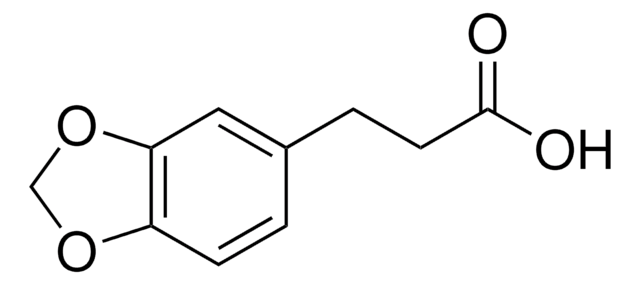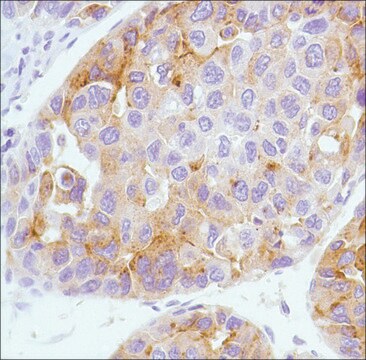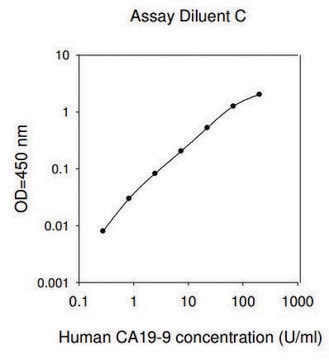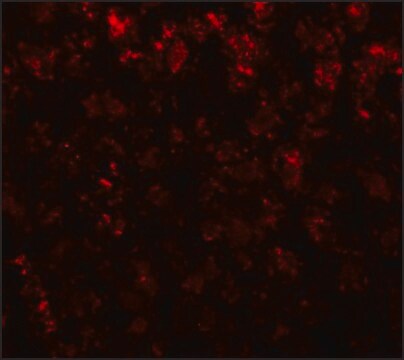RAB0602
Human AFP / Alpha-fetoprotein ELISA Kit
for serum, plasma, cell culture supernatants and urine
Sign Into View Organizational & Contract Pricing
All Photos(1)
About This Item
UNSPSC Code:
41116158
NACRES:
NA.32
Recommended Products
species reactivity
human
packaging
kit of 96 wells (12 strips x 8 wells)
technique(s)
ELISA: suitable
input
sample type urine
sample type plasma
sample type serum
sample type cell culture supernatant(s)
assay range
inter-assay cv: <12%
intra-assay cv: <10%
sensitivity: 6 pg/mL
standard curve range: 7.373-1800 pg/mL
detection method
colorimetric
shipped in
wet ice
storage temp.
−20°C
Gene Information
human ... AFP(174)
General description
The AFP ELISA kit provides for the quantitative measurement of Alpha-fetoprotein in Cell Culture Supernatants, Plasma and Serum.
Application
Please refer to the attached General ELISA KIT Procedure (sandwich, competitive & Indirect ELISA)
Human α-fetoprotein (AFP) ELISA kit has been used to detect levels of AFP in comparison with photoelectrochemical (PEC) immunosensor.
Human α-fetoprotein (AFP) ELISA kit has been used to detect levels of AFP in comparison with photoelectrochemical (PEC) immunosensor.
Biochem/physiol Actions
α-fetoprotein (AFP) facilitates the regulation of fatty acids in both fetal and proliferating adult liver cells. Overexpression of the gene has been observed in acute liver injuries, indicating active liver regeneration. AFP has been associated with fatty liver disease (FLD), a disease that may lead to cirrhosis and hepatocellular carcinoma. It functions as a tumor marker for HCC (hepatocellular carcinoma).
Other Notes
A sample Certificate of Analysis is available for this product.
Please type the word sample in the text box provided for lot number.
Please type the word sample in the text box provided for lot number.
Kit Components Also Available Separately
Product No.
Description
SDS
signalword
Warning
hcodes
pcodes
Hazard Classifications
Met. Corr. 1
Storage Class
8A - Combustible corrosive hazardous materials
flash_point_f
Not applicable
flash_point_c
Not applicable
Choose from one of the most recent versions:
Already Own This Product?
Find documentation for the products that you have recently purchased in the Document Library.
Customers Also Viewed
Suzy Fayez Ewida et al.
Applied immunohistochemistry & molecular morphology : AIMM, 25(10), 736-745 (2016-05-07)
It is still a matter of debate as to whether in vitro mesenchymal stem cell (MSC)-derived hepatocytes may efficiently repopulate a host liver to provide adequate functional substitution. The aim of this study is to assess the efficacy and consistency
Garima Singhal et al.
Molecular metabolism, 13, 56-66 (2018-05-14)
Non-alcoholic fatty liver (NAFL) associated with obesity is a major cause of liver diseases which can progress to non-alcoholic steatohepatitis, cirrhosis, and hepatocellular carcinoma (HCC). Fibroblast growth factor 21 (FGF21) plays an important role in liver metabolism and is also
Abdel Hady A Abdel Wahab et al.
Biomarkers : biochemical indicators of exposure, response, and susceptibility to chemicals, 22(7), 621-628 (2016-10-30)
The incidence rate of hepatocellular carcinoma (HCC) is higher in developing countries, and most cases are associated with chronic hepatitis C virus (HCV) infection. To evaluate the circulating proteins as liver biomarkers for the identification of HCC associated with HCV
Gerda de Vries et al.
Scientific reports, 10(1), 18938-18938 (2020-11-05)
Testicular cancer (TC) is the most common solid tumour in young men. While cisplatin-based chemotherapy is highly effective in TC patients, chemoresistance still accounts for 10% of disease-related deaths. Pre-clinical models that faithfully reflect patient tumours are needed to assist
Novel photoelectrochemical immunosensor for disease-related protein assisted by hemin/G-quadruplex-based DNAzyme on gold nanoparticles to enhance cathodic photocurrent on p-CuBi2O4 semiconductor.
Lv S, et al.
Biosensors And Bioelectronics, 96, 317-323 (2017)
Our team of scientists has experience in all areas of research including Life Science, Material Science, Chemical Synthesis, Chromatography, Analytical and many others.
Contact Technical Service











